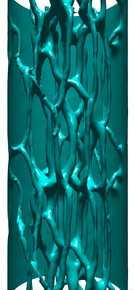Rotating quantum turbulence in the unitary Fermi gas

Figure taken from:
arXiv:2010.15631
K. Hossain, K. Kobuszewski, M. M. Forbes, P. Magierski, K. Sekizawa, G. Wlazłowski,
Rotating quantum turbulence in the unitary Fermi gas,
Phys. Rev. A 105, 013304 (2022) [arXiv:2010.07464],
In the calculations, st-wslda-2d was used initial states generator and td-wslda-3d as time evolver.
Click here to see gallery.
Quantized vortices carry the angular momentum in rotating superfluids, and are key to the phenomenon of quantum turbulence. Advances in ultracold-atom technology enable quantum turbulence to be studied in regimes with both experimental and theoretical control, unlike the original contexts of superfluid helium experiments. While much work has been performed with bosonic systems, detailed studies of fermionic quantum turbulence are nascent, despite wide applicability to other contexts such as rotating neutron stars. In this paper, we present a large-scale study of quantum turbulence in rotating fermionic superfluids using an accurate time-dependent density functional theory called the superfluid local density approximation. We identify two different modes of turbulent decay in the dynamical equilibration of a rotating fermionic superfluid, and contrast these results with a computationally simpler description provided by the Gross-Pitaevskii equation, which we find can qualitatively reproduce these decay mechanisms if dissipation is explicitly included. These results demonstrate that dissipation mechanisms intrinsic to fermionic superfluids play a key role in differentiating fermionic from bosonic turbulence, which manifests by enhanced damping of Kelvin waves.
